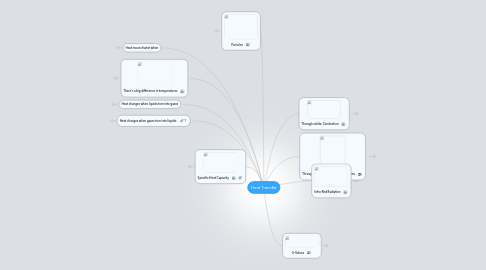
1. There's a big difference in temperatures
1.1. houses lose heat faster in winter when the temperature difference with the outside is bigger
2. Particles
2.1. Solids
2.1.1. vibrate
2.1.1.1. and make next door neighbours vibrate
2.1.1.1.1. and this is how heat gets from hot places to cold places
2.1.2. metals
2.1.2.1. good conductors
2.1.2.1.1. free electrons pass vibrations faster
2.1.3. non-metals
2.1.3.1. "Insulators"
2.2. Liquids
2.2.1. particles flow past each other
2.2.2. still touching
2.3. Gases
2.3.1. spaced apart
2.3.2. fast
3. Heat moves faster when
3.1. You have big surfaces, not small surfaces
3.1.1. Big African elephant ears cool faster than smaller Indian elephants
3.1.2. Cooling fins on computers have big areas
4. Heat changes when liquids turn into gases
4.1. Evaporation
4.1.1. The object the liquid leaves is left colder
4.1.1.1. because the more energetic particles have left the object when they turned into a gas
4.1.1.2. Sweating
5. Heat changes when gases turn into liquids
5.1. Condensation
5.1.1. When the gas turns to a liquid, the object it settles on gets hotter
5.1.1.1. because gas particles turning back into liquid give their extra 'gas energy' to whatever they touch
5.1.1.2. Kitchen steamers
6. Specific Heat Capacity
6.1. A number for how much heat a material can store?
6.1.1. mass
6.1.2. type of material
6.1.3. temperature rise (or change)
6.1.4. Uses
6.1.4.1. Oil and water are used in household radiators ...
6.1.4.1.1. ...because they store and give out a lot of energy per gram for each single degree of temperature rise
7. Through solids: Conduction
7.1. Insulators
7.1.1. not so great letting heat through
7.1.1.1. Home uses
7.1.1.1.1. Loft Insulation
7.1.1.1.2. Cavity wall insulation
7.1.1.1.3. Double Glazing
7.2. Conductors
7.2.1. great at letting heat through
7.2.1.1. Home uses
7.2.1.1.1. pans
7.2.1.1.2. heat sinks
8. Through Liquids and gases: Convection
8.1. particles heat up and spread out
8.2. these places rise up
8.3. colder not-so-spaced-out places get pulled in and get heated up...
8.4. ... this process continues
9. Infra-Red Radiation
9.1. a type of light that you can't see but which heats things up
9.1.1. Good @ giving off
9.1.1.1. "Emitting"
9.1.1.1.1. Black = best
9.1.1.1.2. Dark colours better than
9.1.1.1.3. Lighter colours
9.1.1.1.4. Shiney surfaces worst
9.1.2. Good @ taking in
9.1.2.1. "Absorbing"
9.1.2.1.1. Black = best
9.1.2.1.2. Dark colours better than
9.1.2.1.3. Lighter colours
9.1.2.1.4. Shiney surfaces worst
9.1.3. Uses in the home
9.1.3.1. Solar Panels
9.1.3.1.1. black surfaces absorb more infra red and get hotter faster
9.1.3.2. Fridges have black cooling pipes
9.1.3.2.1. to get rid of heat taken from the foods inside
10. U-Values
10.1. House materials that stop heat loss
10.1.1. High number = poor insulator (let's heat escape)
10.1.2. Small number = good insulator (stops heat escaping)

